To let users access a client-to-site IPsec VPN without having to install X.509 certificates on their client devices, you can create an IPsec client-to-site VPN group policy using a pre-shared key (PSK). For users with mobile devices that are not managed by a mobile device management platform (MDM), using a PSK is more convenient than having to install client certificates for authentication. To allow multiple concurrent client-to-site connections for a single user, an Advanced Remote Access subscription is required. You can connect from any IPv4 or IPv6 address, as long as an external IPv4 and IPv6 address are configured as a service IP address for the VPN service.

Supported VPN Clients
Although any standard-compliant IPsec client should be able to connect via IPsec, Barracuda Networks recommends using to the following clients:
- CudaLaunch via VPN templates in SSL VPN. For more information, see How to Configure VPN Group Policies in the SSL VPN.
- Native iOS IPsec VPN Client
Starting with version 12, Android no longer supports IKEv1. For installation using IKEv2, see Native Android IPsec VPN Client.
Before You Begin
- Set up the VPN certificates for External CA. For more information, see How to Set Up External CA VPN Certificates.
- Configure an external or local authentication service. For more information, see Authentication.
- Identify the subnet (static route) or a range in a local network (proxy ARP) to be used for the VPN clients.
- Identify the IPv4 and IPv6 addresses the VPN service is listening on. If you are using a dynamic IPv4 WAN, see How to Configure VPN Access via a Dynamic WAN IP Address.
Step 1. Configure the VPN Service Listeners
Configure the IPv4 and IPv6 listener addresses for the VPN service.
- Go to CONFIGURATION > Configuration Tree > Box > Assigned Services > VPN-Service > Service Properties.
- Click Lock.
From the Service Availability list, select the source for the IPv4 listeners of the VPN service.
When selecting Explicit, click + for each IP address and enter the IPv4 addresses in the Explicit Service IPs list.
- Click + to add an entry to the Explicit IPv6 Service IPs.
- Select an IPv6 listener from the list of configured explicit IPv6 service IP addresses.
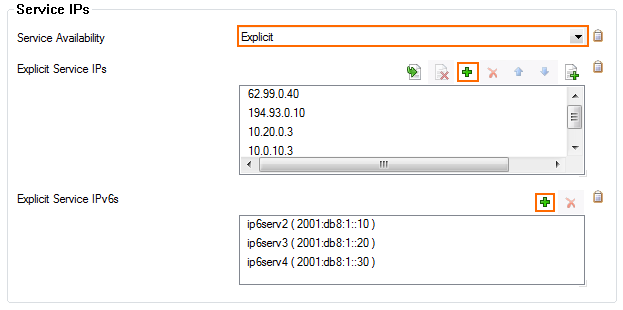
- Click Send Changes and Activate.
Step 2. Configure the Client Network, Gateway, and PSK Key
- Go to CONFIGURATION > Configuration Tree > Box > Assigned Services > VPN > VPN Settings .
- Click Lock.
- Verify that the Default Server Certificate and Private key are both valid (green). If the Default Server Certificate and Private key are not valid, see How to Set Up Barracuda VPN CA VPN Certificates.
- In the left menu, select IPsec.
In the IKEv1 section, enter the Pre-shared key. E.g.,
pre$haredKey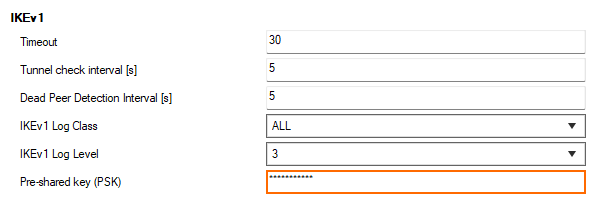
- Configure the client network.
- In the left menu, select Client Networks.
- Right-click the table and select New Client Network. The Client Network window opens.
In the Client Network window, configure the following settings:
Name – Enter a descriptive name for the network.
- Type – Select routed (Static Route). VPN clients are assigned an address via DHCP (fixed or dynamic) in a separate network reserved for the VPN. A static route on the firewall leads to the local network.
Network Address – Enter the base network address for the VPN clients. E.g.,
192.168.6.0Gateway – Enter the gateway network address. E.g.,
192.168.6.254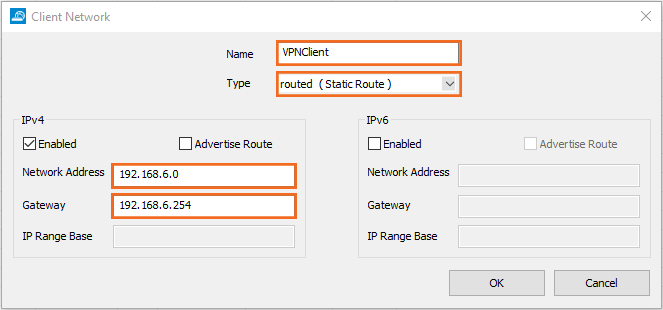
Click OK.
- Click Send Changes and Activate.
Step 3. Configure VPN Group Match Settings
Configure the global authentication settings for VPN tunnels using an external X.509 certificate and group configurations.
- Go to CONFIGURATION > Configuration Tree > Box > Assigned Services > VPN-Service > Client to Site.
- Click Lock.
- Click the External CA tab.
- Click the Click here for options link. The Group VPN Settings window opens.

- Select the Authentication Scheme:
- Default Authentication Scheme – The default authentication scheme is used for all VPN group policies.
- Extract from username – The authentication scheme is appended to the username. The authentication scheme with the appended name is used with the default authentication scheme acting as a fallback if the authentication scheme name is not present on the firewall. E.g.,
user1@msad1oruser2@domain.com@HQldap.
- Select the Default Authentication Scheme from the drop-down list. This authentication scheme must be configured on box level of the firewall.
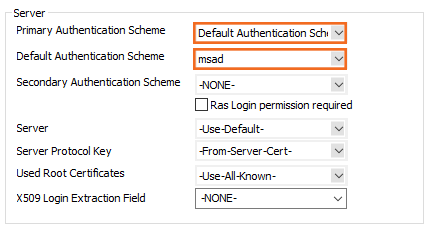
- Click OK.
- Click Send Changes and Activate.
Step 4. Create a VPN Group Policy
The VPN Group Policy specifies the network IPsec settings. You can create group patterns to require users to meet certain criteria, as provided by the group membership of the external authentication server (e.g., CN=vpnusers*). You can also define conditions to be met by the certificate (e.g., O(Organization) must be the company name).
- Go to CONFIGURATION > Configuration Tree > Box > Assigned Services > VPN-Service > Client to Site.
- Click Lock.
- Click the External CA tab, and then click the Group Policy tab.
- Right-click the table and select New Group Policy. The Edit Group Policy window opens.
Enter a name for the Group Policy.
From the Network list, select the VPN client network.
In the Network Routes table, enter the network that must be reachable through the VPN connection. For example,
10.10.200.0/24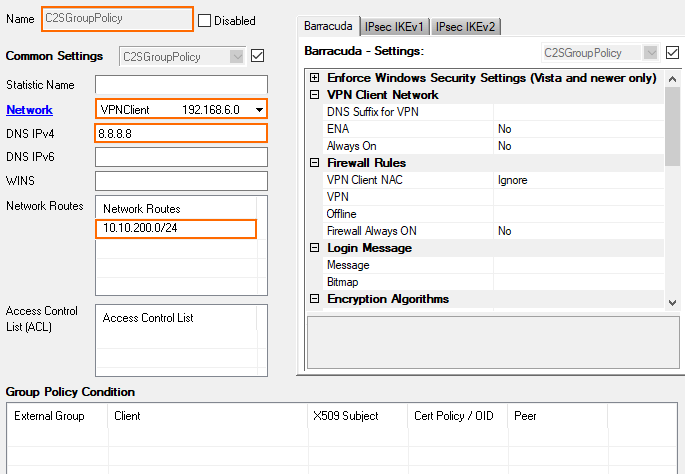
- Configure the group policy.
- Right-click the Group Policy Condition table and select New Rule. The Group Policy Condition window opens.
- In the Group Pattern field, define the groups that will be assigned the policy. E.g.,
CN=vpnusers* - In the Peer Condition section, verify that IPsec Client check box is selected.
- To use this group policy for SSL-VPN VPN template resources and CudaLaunch, enable Barracuda Client.
- Click OK.
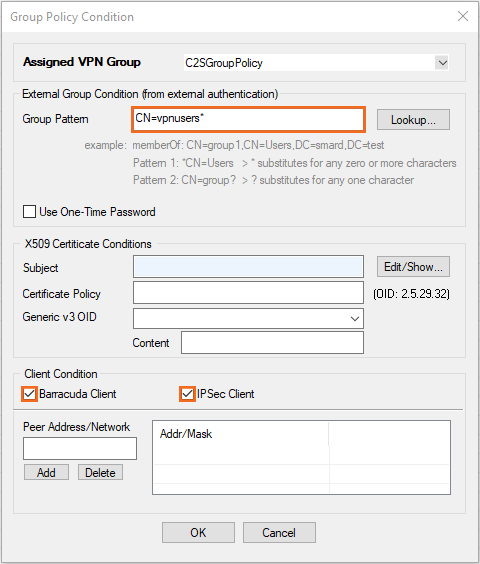
- Configure the encryption and hashing settings:
- Click the IPsec tab.
- Clear the check box in the top-right corner.
- From the IPsec Phase II - Settings list, select the entry that includes (Create New) in its name. For example, if you choose Group Policy as a name, the entry name is Group Policy (Create new).
- Set the following encryption algorithm settings for Phase II:
- Encryption – Select AES256.
- Hash Meth. – Select SHA.
DH-Group – Select None.
- Time – Enter
3600 - Minimum – Enter
1200 - Maximum – Enter
28800
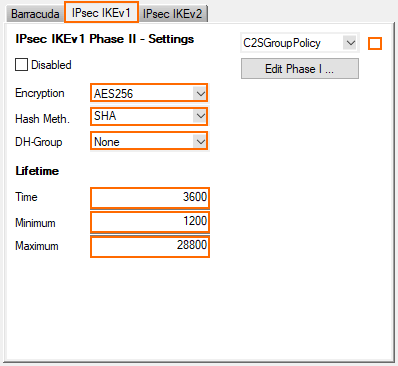
- Click Edit IPsec Phase I and select the encryption algorithm in the For XAuth Authentication section:
- Encryption – Select AES256.
- Hash Meth. – Select SHA.
DH-Group – Select Group2.
- Time – Enter
3600 - Minimum – Enter
1200 - Maximum – Enter
86400
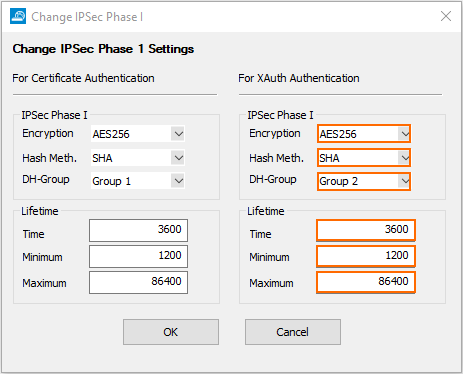
- Click OK.
- Click OK.
- Click Send Changes and Activate.
Step 5. Add Access Rules
Add two access rules to connect your client-to-site VPN to your network.
For more information, see How to Configure an Access Rule for a Client-to-Site VPN.
Monitoring VPN Connections
On the VPN > Client-to-Site page, you can monitor VPN connections.

The page lists all available client-to-site VPN tunnels. In the Tunnel column, the color of the square indicates the status of the VPN:
- Blue – The client is currently connected.
- Green – The VPN tunnel is available, but not in use.
- Grey – The VPN tunnel is disabled. To enable the tunnel, right-click it and select Enable Tunnel.
For more information about the VPN > Client-to-Site page, see VPN Tab.
Troubleshooting
To troubleshoot VPN connections, see the /VPN/VPN and /VPN/ike log files. For more information, see LOGS Tab.
Next Steps
Configure the remote access clients to connect to the client-to-site VPN.
For more information, see Remote Access Clients.
